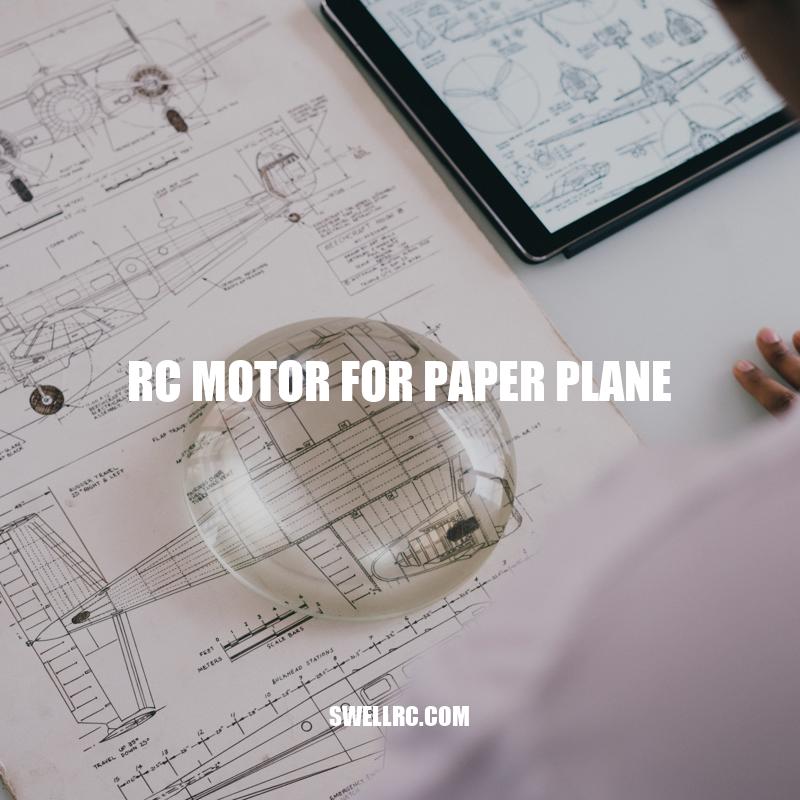Fly High with an RC Motor for Paper Planes
Paper planes are simple and affordable toys that can provide hours of entertainment. Many people enjoy the challenge of creating unique paper plane designs and testing them out for distance and durability. However, some may find that the thrill of paper planes can fade over time. If you’re looking for a way to add a new level of excitement to your paper plane flying experience, consider adding an RC motor to your plane. With an RC motor, you can take your paper planes to new heights, adding power and speed to your designs. RC motors made for paper planes are small, lightweight, and easy to install, making them an excellent choice for beginners or hobbyists looking to take their paper plane game to the skies. In this article, we’ll discuss what an RC motor is, how to select the right one for your paper plane, and the steps required to install it. Get ready to take your paper planes to the next level with the thrill of an RC motor.
Selecting the Right RC Motor for Your Paper Plane
When selecting an RC motor, it is important to consider the weight of the motor and how it will impact the weight and balance of your paper plane. Here are some things to keep in mind:
- Choose a motor that is lightweight and small to minimize the impact on your paper plane’s flight.
- Consider the voltage and power output of the motor to ensure it is appropriate for your plane’s size and weight.
- Brushed DC motors are a common choice for paper planes, as they are lightweight and easy to install.
- Brushless DC motors are a more powerful option but may require additional modifications to your paper plane.
Fortunately, many retailers offer specific RC motors designed for paper planes. Websites like Amazon and HobbyKing offer a variety of options with different specifications and features to choose from. Some even come with complete kits that include everything you need to install an RC motor onto your paper plane. Before making your purchase, be sure to compare different models and read reviews to find the best one for your needs.
How big of a motor do I need for my RC plane?
Choosing the perfect motor for your RC plane is crucial for a successful and enjoyable flying experience. The size and weight of your aircraft will determine what type of electric motor you need. So, how do you know what size motor you need?
The power of electric motors is measured in watts, with 750 watts equaling one horsepower. An easy way to estimate the power needs for your RC plane is to use 100 watts per pound for sport flying, 150 watts per pound for aggressive aerobatics, and 200 watts per pound for 3D flying. This formula provides a good starting point for selecting a motor that can provide the necessary power for your plane to fly at its best.
To find the weight of your plane, you can use a scale or check the product specifications provided by the manufacturer. Once you have an idea of your aircraft’s weight, you can use the formula to determine how many watts your motor needs to generate enough power to get your plane off the ground and keep it flying.
It’s important to note that other factors, such as propeller size, battery type, and ESC (Electronic Speed Control), can also affect the performance of your RC plane. Therefore, it’s essential to do your research and choose a motor that suits your specific needs and fits within your budget.
In summary, the size of the motor you need for your RC plane depends on the weight of the aircraft and the type of flying you plan to do. By using a formula based on watts per pound, you can estimate the power requirements for your plane and choose a motor that will help your RC plane soar through the skies.
Installation and Set-Up of Your RC Motor
Once you have selected your RC motor, it is time to install it onto your paper plane. Here are some steps to follow:
- Begin by cutting a small hole in the back of your paper plane. The hole should be just large enough to insert the motor.
- Insert the motor into the hole, and secure it in place using adhesive tape or glue.
- Be sure to connect the motor to a battery that is appropriate for its voltage and power output.
- Test the plane by throwing it a few times to ensure that the motor is properly connected and the paper plane is still capable of stable flight.
It is important to note that adding an RC motor to your paper plane can significantly impact your flight experience. Here are some interesting facts about the effect of an RC motor on paper planes:
| Motor Type | Impact on Flight |
|---|---|
| Brushed DC Motor | Minimal impact on flight due to lightweight design. |
| Brushless DC Motor | Increased power and speed, but requires more modifications to the paper plane. |
If you are new to the world of RC motors for paper planes, it is important to do your research and invest in quality products to ensure a successful experience. Websites like Flite Test and Instructables offer informative articles and tutorials on how to install and set up your RC motor. Consider joining online communities and forums to connect with other paper plane enthusiasts and learn from their experiences.
How to install rc airplane hinges?
Installing hinges in your RC airplane can be a daunting task for any model builder. However, with a few simple steps, you can easily install hinges like a professional.
Firstly, it’s important to choose the right type of hinge for your plane. There are various types of hinges available, including pin hinges, tape hinges, and the classic CA hinges. You can select the hinge that is best suited for your model.
Next, you need to prepare the wing and control surface where the hinge will be installed. Make sure the surfaces are clean, and sand down any rough edges. This will ensure the best possible hinge placement and longevity.
Once the surfaces are prepared, you can begin installing the hinges. With pin hinges, you can simply drill holes on the surface to be hinged and push the hinge pins through the holes. For tape hinges, you can use double-sided tape to attach the hinge to the surface. For CA hinges, you can apply a thin layer of CA glue to one side of the hinge, attach it to the surface, and provide a few seconds for the glue to dry.
It’s important to ensure that the hinges are placed symmetrically on both the wing and control surface to avoid any binding or twisting. Once you’re done with the placement, you should check the surface’s freedom of movement to make sure the hinges are properly installed.
In conclusion, the hinge is a crucial part of your RC plane’s functionality. It’s essential to choose the right type of hinge and install it correctly to ensure a smooth and durable operation. With a bit of care and attention to detail, you can easily install hinges, like a pro.
Precautions to Take when Operating Your Paper Plane with an RC Motor
Before you launch your paper plane with an RC motor, it’s important to take some safety precautions. Here are some things to keep in mind:
- Always operate your paper plane away from crowded areas and away from people and objects that could be damaged during flight.
- Make sure the battery is properly installed and charged before you launch your plane.
- Avoid flying in areas with strong winds that could disrupt the flight of your paper plane.
- Be sure to keep your remote control on-hand to pilot your plane and avoid losing control during flight.
Additionally, it’s important to consider the environment and regulations in your area when flying your paper plane with an RC motor. Here are some additional keywords to keep in mind:
- FAA regulations for hobby drone flight
- Outdoor space considerations for RC plane and drone pilots
- Environmental factors that can impact flight and safety
Websites like Amazon, HobbyKing, and Horizon Hobby offer a wide range of RC motor kits that are designed specifically for paper planes. Investing in quality products can help ensure a safe and successful experience. Additionally, consider joining online communities and forums where paper plane enthusiasts and RC pilots share their own experiences and tips for flying with an RC motor.
What motor should I use for RC plane?
When it comes to building an RC plane, selecting the right motor is vital for achieving the perfect balance between weight, power, and performance. But, with so many options out there, it can be tough to decide on which one to choose.
For those just starting out, it’s best to opt for a motor with a kv between 850kv and 1500kv. This range is perfect for beginners as it provides a good amount of power without being too overwhelming. However, it is important to remember that the size of the motor is also a vital factor to consider.
Many newbies make the mistake of choosing a motor that’s too big, resulting in an overpowered plane that can be tough to control. This can lead to crashes and damage to the plane. Therefore, it’s important to choose a motor that matches the weight and size of your aircraft.
A lighter motor with a lower kv rating is perfect for slower planes and offers a smoother, more stable flight experience. On the other hand, a bigger motor with a higher kv rating will provide more power and speed, making it a better option for larger planes.
It’s important to find the right balance when selecting a motor for your RC plane. Choose a motor that’s not too powerful but has enough power to get the job done. This will result in a stable and robust plane that’s easy to maneuver.
Conclusion: Take Your Paper Plane to New Heights with an RC Motor
Adding an RC motor to your paper plane is a great way to take your hobby to the next level and add an extra layer of excitement to your flights. With some careful consideration and a bit of preparation, you can create a stable and well-constructed paper plane that can take to the skies with ease.
However, it’s important to remember that safety is always a top priority when flying with an RC motor. Be sure to keep your environment, your battery, and your remote control in mind when launching your paper plane.
With a bit of practice and experience, you can take your paper plane flying skills to new heights. Consider joining online communities and forums to learn more from other enthusiasts and share your own experiences as you explore this fun and innovative twist on paper plane making. So, get started on your RC paper plane project today and go have some fun in the sky!



